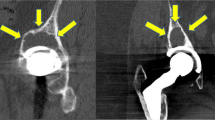Abstract
Radiographs of 72 uncemented hip implants with a mean follow-up of 6.5 years were analysed to measure wear of the implant. The wear rate was measured using the modified technique of Livermore and was found to be 0.13 mm per year (CI 95% 0.080–0.18). There was no statistical correlation between wear and age, gender and cup angle, but there was a correlation between wear and the number and size of cysts. This has not been previously published. In view of the risk of loosening and of a dramatic increase in the rate of wear when the femoral head articulates with the metal backing, it is important to plan revision of these cups in good time and to ensure regular radiographic surveillance of these patients.
Résumé
Nous avons étudié les radiographies de 72 prothèses de la hanche non-cimentées (Landos, France) pour mesurer l'usure de l'insert acétabulaire. Le suivi moyen était 6,5 années. L'usure a été mesuré avec la technique modifiée de Livermore, comme décrit par Rokkum et Reigstad. L'usure par an était 0,13 mm (CI 95% 0,080–0,18). Aucune corrélation statistique n'a été trouvée entre usure et âge, genre et angle de la cupule. Cependant une corrélation significative a été trouvée entre l'usure et la quantité de kystes acétabulaires. Le haut taux d'usure a déjà été publié avec une tête fémorale différente mais la corrélation statistique entre taux d'usure et formation de kystes ne l'a pas été. À cause du risque de descellement et d'usure quand le col fémoral entre en contact avec la cage de métal, il est important de suivre ces malades régulièrement et de prévoir une révision dans le temps.


Similar content being viewed by others
References
Bankston AB, Cates H, Ritter MA, Keating EM, Faris PM (1995) Polyethylene wear in total hip arthroplasty. Clin Orthop 317:7–13
Chen PC, Mead EH, Pinto JG, Colwell CWJr (1995) Polyethylene wear debris in modular acetabular prostheses. Clin Orthop 317:44–56
D'Antonio JA, Capello WN, Jaffe WL (1992) Hydroxylapatite-coated hip implants. Multicenter three-year clinical and roentgenographic results. Clin Orthop 285:102–115
Devane PA, Robinson EJ, Bourne RB, Rorabeck CH, Nayak NN, Horne JG (1997) Measurement of polyethylene wear in acetabular components inserted with and without cement. A randomized trial. J Bone Joint Surg [Am] 79:682–689
Geesink RG, Hoefnagels NH (1995) Six-year results of hydroxyapatite-coated total hip replacement. J Bone Joint Surg.[Br] 77:534–547
Lai KA, Shen WJ, Chen CH, Yang CY, Hu WP, Chang GL (2002) Failure of hydroxyapatite-coated acetabular cups. Ten-year follow-up of 85 Landos Atoll arthroplasties. J Bone Joint Surg [Br] 84:641–646
Livermore J, Ilstrup D, Morrey B (1990) Effect of femoral head size on wear of the polyethylene acetabular component. J Bone Joint Surg [Am] 72:518–528
Morscher EW, Hefti A, Aebi U (1998) Severe osteolysis after third-body wear due to hydroxyapatite particles from acetabular cup coating. J Bone Joint Surg [Br] 80:267–272
Nashed RS, Becker DA, Gustilo RB (1995) Are cementless acetabular components the cause of excess wear and osteolysis in total hip arthroplasty? Clin Orthop 317:19–28
Oosterbos CJ, Rahmy AI, Tonino AJ (2001) Hydroxyapatite coated hip prosthesis followed up for 5 Years. Int Orthop 25:17–21
Rokkum M, Reigstad A (1998) Polyethylene wear with an entirely HA-coated total hip replacement: 79 hips followed for 5 years. Acta Orthop Scand 69:253–258
Rossi P, Sibelli P, Fumero S, Crua E (1995) Short-term results of hydroxyapatite-coated primary total hip arthroplasty. Clin Orthop 310:98–102
Sochart DH (1999) Relationship of acetabular wear to osteolysis and loosening in total hip arthroplasty. Clin Orthop 363:135–150
Sychterz CJ, Moon KH, Hashimoto Y, Terefenko KM, Engh CA Jr, Bauer TW (1996) Wear of polyethylene cups in total hip arthroplasty. A study of specimens retrieved post mortem. J Bone Joint Surg [Am] 78:1193–1200
Xenos JS, Hopkinson WJ, Callaghan JJ, Heekin R, Savory CG (1995) Osteolysis around an uncemented cobalt chrome total hip arthroplasty. Clin Orthop 317:29–36
Author information
Authors and Affiliations
Corresponding author
Electronic Supplementary Material
Rights and permissions
About this article
Cite this article
van Haaren, E.H., Heyligers, I.C. Implant wear and osteolysis with a hydroxylapatite-coated screw cup. International Orthopaedics (SICOT) 27, 282–285 (2003). https://doi.org/10.1007/s00264-003-0479-0
Accepted:
Published:
Issue Date:
DOI: https://doi.org/10.1007/s00264-003-0479-0




